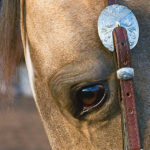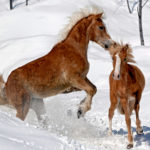 Credit: Thinkstock
Credit: ThinkstockWhen deciding how deeply to bed your stalls, keep in mind that bedding is useless unless it provides comfort and cushioning for the horse, absorbs urine and manure and reduces ammonia odors. On the other hand, bedding that is too deep takes longer to clean, fills up your manure pile more rapidly and wastes money.
When deciding how deeply to bed your stalls, consider the following:
Stall flooring: Concrete or un-matted floors will require more bedding than those are matted. On the other hand, you’ll still need bedding to absorb ammonia. Remember that stall mats and pads are not a free ‘get out of jail’ pass to not use bedding.
Type of bedding: Do you bed with shavings or straw? Peat moss or paper? The density of the bedding material will affect the amount of cushioning it provides.
Horse: Does your horse have a medical condition, such as arthritis or other joint condition, that benefits from additional cushioning? Does he get hock rubs from sleeping in his stall? Hock rubs are a telltale sign that you need to provide more bedding.
Your time and labor: Deeper bedding takes longer to clean and also often generates more waste volume, which takes up room in the dumpster or manure pile.
Costs: How expensive is the bedding and what is your budget? More is more, so 10 bags of shavings will cost you 10 times more than 1 bag of shavings, to put things in very simple terms.
There is a system of bedding that provides excellent cushioning without a requiring a large volume of bedding to maintain once established. It’s called a deep litter system. With this approach, you remove only manure and wet shavings. You leave the dirty bedding in the stall, but cover it with fresh shavings. Eventually, this creates a packed bottom layer that generates heat, keeps fresh shavings on top so the horse stays clean and comfortable, and minimizes mucking time.
Here’s how you get started:
- Pack your stall full of shavings–at least 12” to 18” of shavings from wall to wall
- Bank the walls and corners several feet up to help prevent the horse from getting cast and serve as your reservoir of clean bedding.
- When it’s time to clean the stall, remove the manure. To remove urine, peel away the top layer of bedding, remove the wet shavings, and put the top layer back. Add a new layer of shavings from the banked sides to the middle of the stall.
Daily mucking goes quickly with this method. Periodically, you’ll need to strip the entire stall and start over. But overall, this approach can be both economical for you and comfortable for your horse(s).





